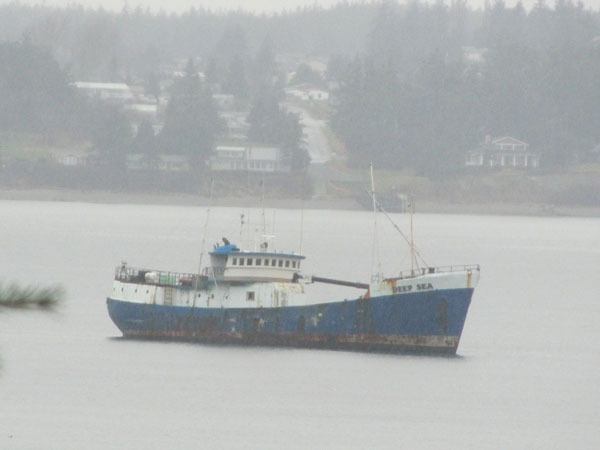Strong currents and the continuation of light oil sheen coming from the 128-foot derelict crab boat that burned and sank in Penn Cove has prompted state officials to solidify and accelerate plans to remove the vessel.
Toni Droscher, spokeswoman for the state Department of Natural Resources, said that the agency has wanted to raise and dispose of the Deep Sea since it sank, May 13, but that it was proceeding cautiously.
However, those plans were made official Monday following a joint meeting with representatives from the multitude of state and federal agencies that have been participating in containment and clean up efforts.
“We did find that (removing the vessel) is the best route to go,” Droscher said. “We can’t put a boom around that boat forever.”
The consensus was reached largely because small sheens have continued to appear above the sunken vessel, though the major diesel leaks are believed to have been contained as of last week Wednesday.
The small sheens observed are nowhere near the size of the one that occurred the day after the sinking, which stretched from the wreck site all the way to the Coupeville Wharf.
“I’m not sure you’d even measure it in gallons,” said Richard Walker, on-scene coordinator for the state Department of Ecology.
The continued appearance of small or light sheen is not altogether unexpected from a sunken ship the size of the Deep Sea, but it does present the possibility for problems over the long term, he said.
“They might stop but when are they going to reemerge again? This year? Next year?” Walker said.
“We really feel this is the best decision for everyone involved,” he said.
The source of the sporadic sheens is still unknown, though Walker said it’s most likely from contaminants trapped in the hull of the vessel. Whether it’s oil, diesel or hydraulic fluid that’s floating to the surface is also unclear.
Lt. Cmdr Wade Gough, chief of the U.S. Coast Guard’s incident management division at Sector Puget Sound in Seattle, said diving operations were initially thought to continue into this week but confirmed that they wrapped up Friday evening.
He reported that two main tanks could not be reached for inspection and that contaminant recovery remains at about 5,200 gallons. About 3,200 gallons were directly syphoned and picked up by surface skimmer boats and as much as 2,000 sopped up with absorbent pads.
Gough said the Coast Guard officially transferred its lead of the clean up and containment efforts to the state Department of Ecology on Friday. The federal agency will now act largely in an advisory role.
According to Ecology spokesman Larry Altose, Ballard Diving & Salvage is no longer under contract but the state agency has retained the services of National Response Corporation.
Both firms were hired by the Coast Guard and had been funded through the federal Oil Spill Liability Trust Fund, a special pot filled with money levied from oil imports. Altose said Ecology is paying for the effort with funds from the state Toxic Control Account, which is funded from taxes on hazardous materials.
Altose could not yet say how much has been spent but Gough said the Coast Guard’s direct costs – hiring the diving firm and NRC – tally about $225,00. That compares to about $450,000 in indirect costs, such as keeping a boat on scene and helicopter patrols over the past week.
According to Gough, indirect costs aren’t usually covered by the vessel’s owner, in this case Rory Westmoreland, but the decision is up to the Coast Guard’s National Pollution Funds Center.
Droscher said the Department of Natural Resources will be working this week to find a contractor to raise the boat. She estimated that the price tag, including disposal costs, would be about $750,000.
“That’s our best guess now,” she said.
The vessel is beginning to fill with mud from the strong currents that flow in and out of Penn Cove, Droscher said. Some reports are that the wheelhouse is already half filled with sediment.
That makes getting the vessel out of there quickly all the more important as the heavier it is the harder it will be to raise it. She said she expects the operation to take place “in the next week or so.”
“Time is definitely of the essence,” she said.
As for the shellfish closure currently in effect in Penn Cove, Mark Toy, an environmental engineer with the state Department of Health, said he didn’t know when that will be lifted.
In order for the cove to be reopened, he said the pollution will need to be totally arrested, surface sheens gone for a period of one week and then testing to confirm shellfish are safe for consumption.
After the initial leak was sealed last Wednesday, Toy said he had been hopeful that the area would be open by this weekend.
“My best estimate was Friday but now I don’t know,” he said.



